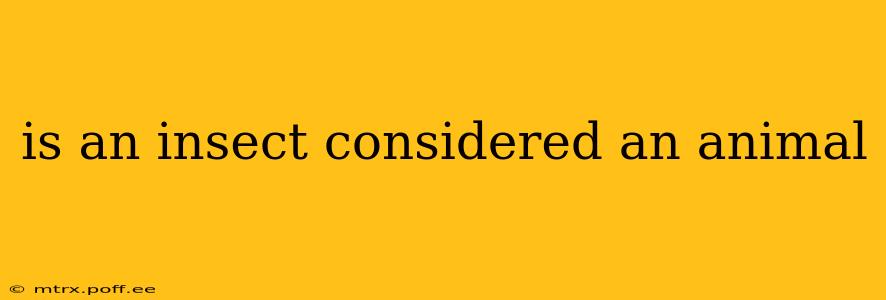Yes, an insect is absolutely considered an animal. This might seem like a simple question with an obvious answer, but understanding why an insect is classified as an animal requires a deeper look into the biological classification system. This article will explore the characteristics that define animals and how insects perfectly fit within that framework. We'll also address some common related questions.
What Defines an Animal?
Before we definitively classify insects, let's establish the key characteristics that define the animal kingdom (also known as Animalia). Animals are multicellular, eukaryotic organisms (meaning their cells have a nucleus). Critically, they are heterotrophic, meaning they cannot produce their own food like plants. Instead, they obtain energy by consuming other organisms, whether plants or other animals. Furthermore, most animals are capable of movement at some point in their life cycle.
How Insects Fit the Animal Bill
Insects, belonging to the class Insecta, perfectly embody these animal characteristics. They are:
- Multicellular: Insects are composed of numerous cells working together to form tissues and organs.
- Eukaryotic: Their cells possess a membrane-bound nucleus and other organelles.
- Heterotrophic: Insects obtain nourishment by consuming plants (herbivores), other animals (carnivores), or both (omnivores). Some even exhibit parasitism.
- Motile (capable of movement): Most insects move using legs, wings, or a combination of both. Even those with sedentary adult stages, like some beetles, are motile during larval phases.
Are Insects Vertebrates or Invertebrates?
This is a common point of confusion. While all animals are either vertebrates or invertebrates, insects are unequivocally invertebrates. This means they lack a backbone or spinal column, a defining characteristic of vertebrates (like mammals, birds, reptiles, amphibians, and fish). Insects belong to the phylum Arthropoda, a vast group of invertebrates also including arachnids (spiders, scorpions), crustaceans (crabs, lobsters), and myriapods (centipedes, millipedes).
What are the main characteristics of insects?
Insects possess several unique characteristics that distinguish them from other invertebrates:
- Three body segments: A head, thorax, and abdomen.
- Six legs: Attached to the thorax.
- Exoskeleton: A hard, protective outer covering made of chitin. This requires molting (shedding) as the insect grows.
- One pair of antennae: Used for sensing their environment.
- (Usually) Wings: Many insects have one or two pairs of wings, allowing for flight.
Why are insects important?
Insects play vital roles in ecosystems worldwide. They are crucial for:
- Pollination: Many plants rely on insects for pollination, ensuring the production of fruits, vegetables, and other crops.
- Decomposition: Insects break down dead organic matter, recycling nutrients back into the environment.
- Food source: Insects are a significant food source for many animals, including birds, reptiles, amphibians, and mammals.
- Pest control: Some insects are natural predators of other insects, helping to control pest populations.
Are spiders insects?
No, spiders are not insects. While both are arthropods, they belong to different classes. Spiders are arachnids, characterized by having eight legs, two body segments (cephalothorax and abdomen), and no antennae. This highlights the importance of precise biological classification.
In conclusion, insects are unequivocally animals. Their characteristics align perfectly with the definition of the animal kingdom, placing them firmly within this broad biological category. Understanding this fundamental classification is crucial for appreciating the incredible diversity and ecological importance of insects.
